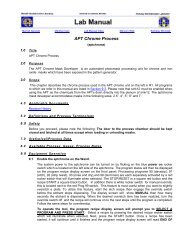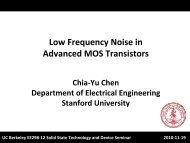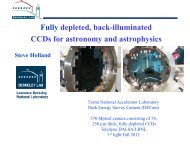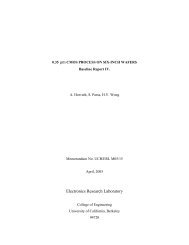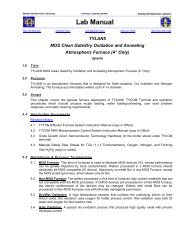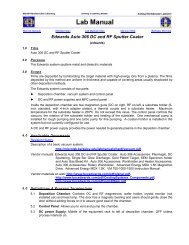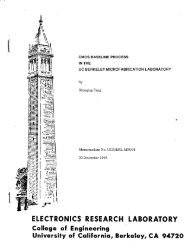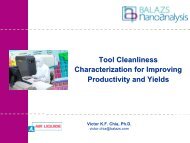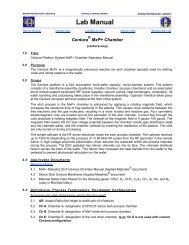Sia Parsa - Berkeley Microlab
Sia Parsa - Berkeley Microlab
Sia Parsa - Berkeley Microlab
Create successful ePaper yourself
Turn your PDF publications into a flip-book with our unique Google optimized e-Paper software.
III. TRANSFERRED AND NEW EQUIPMENT INSTALLATION IN NANOLAB<br />
Process staff generated on-line manuals for newly installed & transferred equipment in the<br />
NanoLab, also evaluated and released standard processes on baseline tools, helped<br />
members continue their process on other equipment in the lab. These activities involved<br />
release of standard recipes on Lam etcher, Tystar furnaces, as well as stepper jobs for<br />
ASML and GCAWS steppers. Matt Wasilik our BSAC engineer helped us release<br />
standard etch processes on the new DRIE STS machines. He worked with graduate<br />
students (Fabian Goerick) to qualify aluminum nitride deposition process in our newly<br />
installed AlN machine, also helped us release flip chip bonder, Ks aligner and KS bonder<br />
in the new lab.<br />
ASML stepper 5500/300 (new tool)<br />
Careful site preparation and planning was warranted in the installation of our new DUV<br />
5500/300 ASML stepper in the NanoLab. Preemptive evaluation of in-house mask making<br />
capability was also important, lack of which could have impacted the cost of operation<br />
dramatically.<br />
Mask generation: A four field mask was fabricated and forwarded to ASML application<br />
engineers to try at IBM San Jose. This was done prior to our stepper arrival to foresee<br />
possible mask making issues that needed to get addressed before the arrival of our new<br />
ASML 5500/300 model stepper (5/3/10).<br />
Training: Two Training sessions were offered to retrain qualified users of the previous<br />
model stepper (5500/90) on the new 5500/300 model (01/06/2011 and 01/12/2011).<br />
Process staff also helped members redesigned their mask onto the new 4X template<br />
currently posted on line, all went extremely well thanks to everyone’s cooperation.<br />
Lens Qualification: A critical part of the stepper site acceptance involved Lens<br />
Qualification test. A complex array of features were printed and measured to rule out<br />
possible lens damage and/or inherent lens problems. ASML needed to demonstrate good<br />
process window for this particular 5500/300 stepper by meeting their specification in<br />
regards to Useable Depth of Focus (UDOF) and Critical Dimension (CD) Uniformity. This<br />
test was initiated after the stepper had gone through its initial setup/qualification and<br />
stabilized for sometimes, as a final step in the overall stepper acceptance process in<br />
NanoLab. Lens qualification utilizes focus exposure matrix (FEM) to determine Useable<br />
Depth of Focus (UDOF) and Critical Dimension (CD) Uniformity through generation of<br />
Bossung curves (spider plot or smiley plots) shown in Figure1 below. Their automated<br />
SEM was used to measure critical dimensions (CD) of printed vertical/horizontal 0.25 µm<br />
test features shot at different focus and exposure settings by the FEM procedure. The CD<br />
values that fell within specified range (0.25 µm + 10%) were summarized in Table -1.<br />
These data were then used to generate the Bossung curves (spider plot or smiley plots) in<br />
Figure 1. Useable Depth of Focus (UDOF) = 1.1 µm (specification > 0.7 µm) and Critical<br />
Dimension (CD) Uniformity Range = 20 nm (specification < 30 nm) were demonstrated by<br />
the lens qualification all within spec. Please note data outside 0.25 µm + 10% CD range<br />
were rejected as out of spec data, hence were not shown in Table1.



